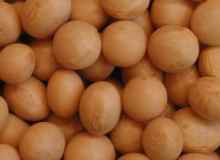Mapping out pathways to better soybeans

Agricultural Research Service (ARS) scientists are a step closer to unlocking genetic clues that may lead to packing more protein and oil into soybeans.
Achieving this would help boost their value and help US growers compete in international markets.
ARS researchers Carroll P. Vance, Yung-Tsi Bolon and Randy C. Shoemaker have narrowed down where genes that determine protein and oil content are likely to be found along the soybean genome. Vance and Bolon work in the ARS Plant Science Research Unit in St. Paul, Minn. and Shoemaker works in the ARS Corn Insects and Crop Genetics Research Unit in Ames, Iowa. The team also included Bindu Joseph, a post doctoral researcher who worked with Shoemaker and is now at the University of California-Davis.
More than half of the estimated $27 bln US soybean crop is exported each year. But there is increasing competition for international markets, and low protein and oil content often deflate prices paid to US growers, particularly in the Midwest.
The researchers used 2 different approaches to compare the genomes of 2 nearly identical inbred lines of soybeans that varied in seed protein and oil content, examining patterns in how thousands of genes are expressed, and sequencing 3 bln base pairs of soybean RNA.
By comparing the results, the researchers drew up a genetic map that identifies key molecular markers along a region of the soybean genome known as Linkage Group I. The widely studied region makes up less than 1% of the plant’s overall genome, but includes 13 “candidate genes” that are likely to play a role in determining oil and protein levels, and a series of associated molecular markers, according to the scientists.
Breeders will be able to use the markers as signposts to enable the development of new soybean lines with higher protein and oil levels. The effort also uncovered evidence showing that protein levels are determined early in the seed’s development.
The report, published online in the journal BMC Plant Biology, also is accompanied by vast amounts of sequencing data that scientists can access to study genes related to other desirable traits, such as drought tolerance and pest resistance.
Source: ARS











